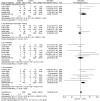Association Between Type 1 Diabetes Mellitus and Eating Disorders: A Systematic Review and Meta-Analysis
- PMID: 38597269
- PMCID: PMC11005101
- DOI: 10.1002/edm2.473
Association Between Type 1 Diabetes Mellitus and Eating Disorders: A Systematic Review and Meta-Analysis
Abstract
Background: Previous meta-analyses have shown mixed results regarding the association between eating disorders (EDs) and type 1 diabetes mellitus (T1DM). Our paper aimed to analyse different EDs and disordered eating behaviours that may be practiced by patients with T1DM.
Methods: A literature search of PubMed, Scopus and Web of Science was conducted on 17 January 2023, using the key terms "T1DM," "Eating Disorders" and "Bulimia." Only observational controlled studies were included. The Revman software (version 5.4) was used for the analysis.
Results: T1DM was associated with increased risk of ED compared with nondiabetic individuals (RR = 2.47, 95% CI = 1.84-3.32, p-value < 0.00001), especially bulimia nervosa (RR = 2.80, 95% CI = 1.18-6.65, p-value = 0.02) and binge eating (RR = 1.53, 95% CI = 1.18-1.98, p-value = 0.001). Our analysis has shown that increased risk of ED among T1DM persisted regardless of the questionnaire used to diagnose ED; DM-validated questionnaires (RR = 2.80, 95% CI = 1.91-4.12, p-value < 0.00001) and generic questionnaires (RR = 2.03, 95% CI = 1.27-3.23, p-value = 0.003). Prevalence of insulin omission/misuse was 10.3%; diabetic females demonstrated a significantly higher risk of insulin omission and insulin misuse than diabetic males.
Conclusion: Our study establishes a significant and clear connection between EDs and T1DM, particularly bulimia and binge eating, with T1DM. Moreover, female diabetics are at higher risk of insulin misuse/omission. Early proactive screening is essential and tailored; comprehensive interventions combining diabetes and ED components are recommended for this population, with referral to a specialised psychiatrist.
Keywords: T1DM; anorexia nervosa; bulimia nervosa; eating disorders.
© 2024 The Authors. Endocrinology, Diabetes & Metabolism published by John Wiley & Sons Ltd.
Conflict of interest statement
The authors declare no conflicts of interest.
Figures














References
-
- Balasundaram P. and Santhanam P., “Eating Disorders,” in StatPearls [Internet] (Treasure Island, FL: StatPearls Publishing, 2023), https://www.ncbi.nlm.nih.gov/books/NBK567717/. - PubMed
Publication types
MeSH terms
Substances
LinkOut - more resources
Full Text Sources
Medical

